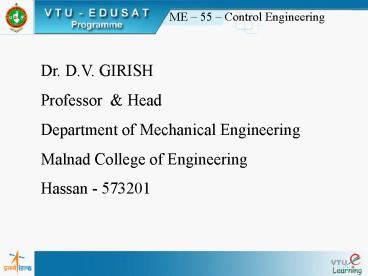Dr' D'V' GIRISH - PowerPoint PPT Presentation
1 / 18
Title:
Dr' D'V' GIRISH
Description:
(b) Lever Measurement. e = (x-y)/2 (c) The change in torque provided. by motor tm = [Km/(1 p) e ... (b) Lever Measurement. e = (x-y)/2. A. Fr. x. 1/2. x-y. y. x ... – PowerPoint PPT presentation
Number of Views:65
Avg rating:3.0/5.0
Title: Dr' D'V' GIRISH
1
ME 55 Control Engineering
Dr. D.V. GIRISH Professor Head Department of
Mechanical Engineering Malnad College of
Engineering Hassan - 573201
2
ME 55 Control Engineering
Transfer Functions
It is defined as the ratio of the laplace
transform of output (response) to the laplace
transform of input (excitation) assuming all the
initial conditions to be zero.
Fig
(a) System in time domain
Fig
(b) System in Laplace domain
Fig Transfer Functions of a system
Dr.D.V.Girish, Professor Head (Mechanical)
MCE, Hassan
3
ME 55 Control Engineering
If G(S) be the transfer function of the system,
we can write mathematically
L.T. of output L.T. of Input
G(S)
all initial conditions are Zero
This Transfer function is a property of the
system itself, independent of the input or
driving function. The T.F includes the units
necessary to relate the input to the output,
However, it does not provide any information
concerning the physical structure of the system.
i.e., the T.F of many physically different
systems can be identical
Dr.D.V.Girish, Professor Head (Mechanical)
MCE, Hassan
4
ME 55 Control Engineering
STEPS TO OBTAIN TRANSFER FUNCTION
- Write the appropriate equation which defines the
behaviour of the element. - Transform this equation assuming all initial
conditions to be zero. - Form the ratio of output C(S) to input R(S)
(a)
(b)
(c)
Dr.D.V.Girish, Professor Head (Mechanical)
MCE, Hassan
5
ME 55 Control Engineering
Consider a spring-mass-damper (k-m-c) system on
which the force F acts and displacement x of
the mass is the output.
.
c
k
Dr.D.V.Girish, Professor Head (Mechanical)
MCE, Hassan
6
ME 55 Control Engineering
Taking laplace transform of each term of this
equation (assuming Zero initial condition), we
can write, F(s) ms2 X(s) cs X(s)
kX(s) Now, taking the ratio of X(s) to F(S) we
can write, the transfer function of the system
Dr.D.V.Girish, Professor Head (Mechanical)
MCE, Hassan
7
ME 55 Control Engineering
Here the highest power of the complex
variable S, in the denominator of the transfer
function determines the order of the system.
Thus the k-m-c system under consideration
is a second order system. Similarly we can write
for k-m system i.e., c 0
and if m0, we can write
Dr.D.V.Girish, Professor Head (Mechanical)
MCE, Hassan
8
ME 55 Control Engineering
BLOCK DIAGRAM
We know that, Input-Output behavior of a Linear
System or Element of a Linear System is given by
Transfer Function, G(s) C(s)/R(s) Where,
R(s) Laplace transformation of the input
Variable C(s) Laplace transformation of
the output Variable
Dr.D.V.Girish, Professor Head (Mechanical)
MCE, Hassan
9
ME 55 Control Engineering
A Convenient graphical representation of this
behaviour, i.e., short hand pictorial
representation of the cause and effect
relationship between the input and out put of a
physical system is known as
BLOCK DIAGRAM
This is shown in Fig (i)
Fig (i)
Dr.D.V.Girish, Professor Head (Mechanical)
MCE, Hassan
10
ME 55 Control Engineering
Here, the signal into the black represents the
input R(S) and signal out of the black represents
the output C(S), while the block itself stands
for transfer function G(S). The flow of
information (Signal) is unidirectional from input
to the output, with the out put being equal to
the input multiplied by the transfer function of
the block. A complex system comprising of
several elements is represented by the
interconnection of the blocks for Individual
elements. The blocks are connected by lines with
arrows indicating the unidirectional, flow of
information from the out put of one block to the
input of the other
Dr.D.V.Girish, Professor Head (Mechanical)
MCE, Hassan
11
ME 55 Control Engineering
In addition to this summing or differencing of
signals is indicated by the symbols shown in the
fig (ii) (a) (b) (c), while take off point of a
signal is represented by fig(iii) i.e., in
summing point two or more signals can
be added or subtracted.
Dr.D.V.Girish, Professor Head (Mechanical)
MCE, Hassan
12
ME 55 Control Engineering
The points at which the output signal of any
block can be applied to two or more points is
known as Take off Point (This output is analogous
to voltage but not to current)
Dr.D.V.Girish, Professor Head (Mechanical)
MCE, Hassan
13
ME 55 Control Engineering
Forward Path
The direction of flow of signal from Input to
output is Known as Forward Path.
Dr.D.V.Girish, Professor Head (Mechanical)
MCE, Hassan
14
ME 55 Control Engineering
Feedback Path
The direction of flow of signal from output to
Input is Known as Feedback Path.
_
Dr.D.V.Girish, Professor Head (Mechanical)
MCE, Hassan
15
ME 55 Control Engineering
- The following Equations refer to a Tension
Regulating Apparatus such as used in the Paper
Industry. - Main Input x
Fr A., - (b) Lever Measurement. e
(x-y)/2 - (c) The change in torque provided
- by motor
tm Km/(1?p) e - (d) Roll tension Fc tm/R
- (e) Tension of Control Spring y 2
Fc/K - Draw individual Block Diagram and
- Determine overall Transfer function
Dr.D.V.Girish, Professor Head (Mechanical)
MCE, Hassan
16
ME 55 Control Engineering
- Solution Individual Block Diagrams
- Main Input x Fr A.,
- (b) Lever Measurement. e (x-y)/2
(c) The change in torque provided by motor
tm (Km/(1 ?p))e
Dr.D.V.Girish, Professor Head (Mechanical)
MCE, Hassan
17
ME 55 Control Engineering
(d) Roll Tension, Fc tm/R
(e) Tension of Control Spring,
y 2 Fc/K
Dr.D.V.Girish, Professor Head (Mechanical)
MCE, Hassan
18
ME 55 Control Engineering
Complete Block diagram and overall transfer
function
Dr.D.V.Girish, Professor Head (Mechanical)
MCE, Hassan































